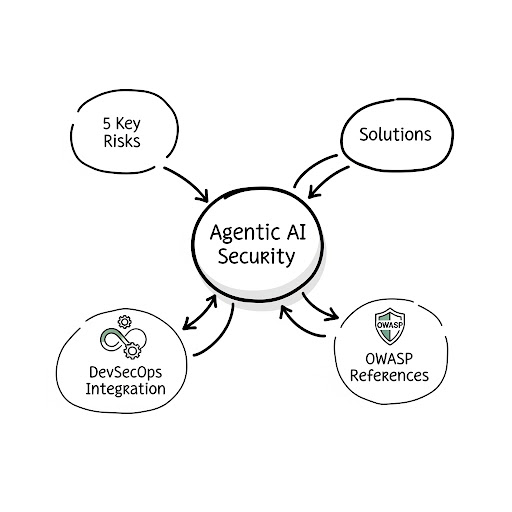Here’s the recipe for securing AI Agents, based on OWASP principles and security best practices. This approach aims to identify risks specific to AI Agents and propose appropriate solutions.

1. The 5 Main Risks
To begin our exploration, we will focus on risks specific to AI Agents, which differ from those of classic LLMs. These risks are often related to the autonomy and action capabilities of agents, making them particularly critical in a security context. Even though classic LLMs can be vulnerable to attacks, AI Agents introduce new challenges due to their ability to act autonomously and interact with external systems.
Here are the 5 main risks we will address:
- Persistent Prompt Injection: Long-lasting manipulation of the agent.
- Tool Hijacking: Abusive use of the agent’s tools.
- Data Leakage: Data exfiltration through agent actions.
- Autonomous Malicious Actions: Dangerous decisions made by the agent without human intervention.
- Code Execution Vulnerability: Code generated or executed by the agent that contains flaws.
2. Solutions and Strategies
For each identified risk, we will propose concrete solutions and mitigation strategies. These solutions are designed to be integrated into your agile development methodology and DevSecOps, to ensure that security is a priority from the beginning of the software development lifecycle (SDLC).
- Securing the “Brain”: Implement guardrails.
- Securing Tools: Apply the principle of least privilege and “Human-in-the-Loop”.
- Protecting the Environment: Use sandboxing and validate data.
- Monitoring: Implement logging and anomaly detection.
3. Integration into the DevSecOps Cycle
We will see how to integrate these solutions into your existing agile development methodology and DevSecOps, without making it more complex. The goal is to ensure that security is a priority from the beginning of the software development lifecycle (SDLC), while maintaining the flexibility and efficiency of agile processes.
- Design: Define the agent’s boundaries.
- CI/CD: Automate security testing (SAST, SCA).
- Production: Implement continuous monitoring and secure secret management.
4. Associated OWASP References
To finalize our approach, we will establish a link between the identified risks and OWASP security frameworks, particularly the OWASP Top 10 for LLM (OWASP LLM AI). This will allow us to validate our approach and ensure that we cover the most critical risks associated with AI Agents.
For each risk, we will reference OWASP controls and recommendations, to ensure that we follow industry-recognized security best practices.